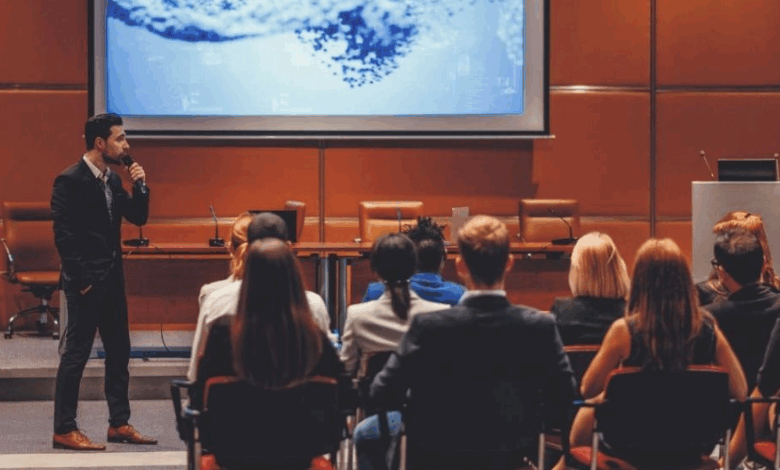
The global conference and events industry is no stranger to disruption. Just a few years ago, the COVID-19 pandemic sent shockwaves through the system, bringing in-person gatherings to a halt and forcing a massive pivot to virtual formats. Many hoped the post-pandemic era would bring a return to stability. Instead, we now face a new kind of uncertainty driven not by public health emergencies, but by economic volatility, geopolitical tensions, and shifting government policies.
Yet again, the global events industry finds itself at a crossroads. International participation, the lifeblood of conferences and events, is under threat. Organizers, presenters, and attendees alike are rethinking how they engage, especially across borders. In this climate, technology is no longer just a support system; it’s a strategic lifeline.
One of the most transformative developments in this space is AI translation. At a time when international participation is harder to coordinate, budgets are tightening, and adaptability is essential, AI translation has become a key driver of meaningful global engagement.
A New Wave of Disruption
Today’s disruption doesn’t come in the form of lockdowns and health mandates, it’s more subtle, but equally powerful. Economic uncertainty is causing many organizations to scale back travel and event participation. Reports suggest international inbound travel to the U.S. is down 15%, and that trend echoes globally. For conferences that rely on the presence of international delegates, speakers, and partners, this poses a direct threat.
Layered on top are the growing challenges of geopolitics, including visa delays, trade tensions, and ever-evolving policy shifts. These forces can trigger last-minute cancellations, limit participation from key regions, and disrupt the finely tuned logistics behind every major event.
Then there’s the financial squeeze. Rising inflation and government austerity measures are cutting deep into event budgets. Interpretation services, once a staple at many global gatherings, are increasingly difficult to justify. In-person interpreters can cost thousands of dollars per session, and the logistics around managing equipment and schedules only add to the complexity.
The Rise of AI Translation
In today’s shifting landscape, AI translation is now a necessity. These tools use artificial intelligence to deliver real-time translation and captions in multiple languages, making multilingual communication possible without the complexity or high cost of traditional interpretation.
Unlike conventional methods, AI translation platforms can be deployed with minimal setup and no specialized hardware. They’re accessible and easily integrated into virtual, hybrid, and in-person environments. More importantly, they enable consistent participation and engagement across diverse audiences.
We’re already seeing successful examples of this in action. The European Association for Osseointegration (EAO) started using AI translation at its 2023 annual congresses to support thousands of attendees from over 80 countries. Real-time multilingual access allowed participants to follow complex scientific sessions in their preferred language using their own devices. Languages like Chinese, Turkish, German, and Japanese saw especially high engagement, clear evidence of the demand for inclusive access.
Similarly, the International Society of Nephrology (ISN) employes AI translation at their World Congress of Nephrology, which draws more than 4,000 kidney care professionals from over 100 countries. With over 240 speakers and sessions addressing regional challenges, the ability to provide real-time captions and translations in multiple languages helped foster deeper global collaboration and improved learning outcomes across continents.
People are more likely to engage, contribute, and return when they can participate in their own language, no matter where they are or how difficult travel may be. That’s the future of global events, making everyone feel included.
Beyond the Bottom Line
Cost savings are often the first thing people mention when talking about AI translation. In some cases, it can cut expenses by 75% or more compared to traditional methods. But the real value goes beyond money. Events using AI translation are more resilient and can reach wider audiences. They don’t just survive disruptions; they thrive despite them.
This kind of flexibility defines future-ready organizations. It’s no longer enough to have a backup plan. The events industry must build with flexibility at its core, ready to adapt not just to a single crisis, but to a world in which uncertainty is the new normal.
That’s where AI stands out by adapting fast working for large groups. Language used to be a barrier, but now it’s a bridge with global participation being the norm.
A More Inclusive Global Stage
There’s another dimension that shouldn’t be overlooked. In many cases, language has long been an invisible gatekeeper. Entire communities and regions have been excluded from global conversations simply because they lacked translation support. With AI, we now have the power to lower that gate broadly and effectively.
Imagine a scientific summit where researchers from Latin America, Southeast Asia, and Eastern Europe can fully participate in real time. Or an educational conference where students and teachers in under-resourced regions can listen, learn, and contribute in their own language. This is not a distant vision. It is already happening.
The Path Forward
The global events industry is being reshaped in real time. Much like the early 2020s forced us to reimagine formats and venues, today’s environment is compelling us to rethink how we connect across borders. AI translation is not a silver bullet, but it is a powerful tool that allows us to break language barriers without breaking budgets or plans.
As we move into this next chapter, the question is not whether we’ll continue to face disruption. We will. The real question is whether we’ll have the tools, mindset, and infrastructure to meet it head-on.
Global events are more than just planning. They’re about connection, collaboration, and progress. With today’s advanced technology, language should never be a barrier. Let’s ensure seamless communication between everyone involved.





